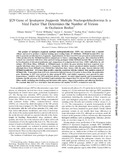Mostrar el registro sencillo del ítem
Sf29 Gene of Spodoptera frugiperda multiple nucleopolyhedrovirus is a viral factor that determines the number of virions in occlusion bodies
| dc.creator | Simón de Goñi, Oihane | es_ES |
| dc.creator | Williams, Trevor | es_ES |
| dc.creator | Asensio, Aarón C. | es_ES |
| dc.creator | Ros Terés, Sarhay | es_ES |
| dc.creator | Gaya Cacho, Andrea | es_ES |
| dc.creator | Caballero Murillo, Primitivo | es_ES |
| dc.creator | Possee, Robert D. | es_ES |
| dc.date.accessioned | 2019-01-21T13:24:47Z | |
| dc.date.available | 2019-01-21T13:24:47Z | |
| dc.date.issued | 2008 | |
| dc.identifier.issn | 0022-538X (Print) | |
| dc.identifier.issn | 1098-5514 (Electronic) | |
| dc.identifier.uri | https://hdl.handle.net/2454/32034 | |
| dc.description.abstract | The genome of Spodoptera frugiperda multiple nucleopolyhedrovirus (NPV) was inserted into a bacmid (Sfbac) and used to produce a mutant lacking open reading frame 29 (Sf29null). Sf29null bacmid DNA was able to generate an infection in S. frugiperda. Approximately six times less DNA was present in occlusion bodies (OBs) produced by the Sf29null bacmid in comparison to viruses containing this gene. This reduction in DNA content was consistent with fewer virus particles being packaged within Sf29null bacmid OBs, as determined by fractionation of dissolved polyhedra and comparison of occlusion-derived virus (ODV) infectivity in cell culture. DNA from Sfbac, Sf29null, or Sf29null-repair, in which the gene deletion had been repaired, were equally infectious when used to transfect S. frugiperda. All three viruses produced similar numbers of OBs, although those from Sf29null were 10-fold less infectious than viruses with the gene. Insects infected with Sf29null bacmid died 24 h later than positive controls, consistent with the reduced virus particle content of Sf29null OBs. Transcripts from Sf29 were detected in infected insects 12 h prior to those from the polyhedrin gene. Homologs to Sf29 were present in other group II NPVs, and similar sequences were present in entomopoxviruses. Analysis of the Sf29 predicted protein sequence revealed signal peptide and transmembrane domains, but the presence of 12 potential N-glycosylation sites suggest that it is not an ODV envelope protein. Other motifs, including zinc-binding and threonine-rich regions, suggest degradation and adhesion functions. We conclude that Sf29 is a viral factor that determines the number of ODVs occluded in each OB. | en |
| dc.description.sponsorship | This work was supported by core CEH funds. O.S. received a Spanish Ministry of Education and Culture postdoctoral fellowship. | en |
| dc.format.extent | 8 p. | |
| dc.format.mimetype | application/pdf | en |
| dc.language.iso | eng | en |
| dc.publisher | American Society for Microbiology | en |
| dc.relation.ispartof | Journal of Virology, Aug. 2008, Vol. 82, No. 16, p. 7897–7904 | en |
| dc.rights | © 2008, American Society for Microbiology. All Rights Reserved. | en |
| dc.subject | Spodoptera frugiperda | en |
| dc.subject | Nucleopolyhedroviruses | en |
| dc.subject | Sf29 | en |
| dc.subject | Occlusion bodies | en |
| dc.subject | Virions | en |
| dc.title | Sf29 Gene of Spodoptera frugiperda multiple nucleopolyhedrovirus is a viral factor that determines the number of virions in occlusion bodies | en |
| dc.type | info:eu-repo/semantics/article | en |
| dc.type | Artículo / Artikulua | es |
| dc.contributor.department | Producción Agraria | es_ES |
| dc.contributor.department | Nekazaritza Ekoizpena | eu |
| dc.contributor.department | IdAB. Instituto de Agrobiotecnología / Agrobioteknologiako Institutua | es |
| dc.rights.accessRights | info:eu-repo/semantics/openAccess | en |
| dc.rights.accessRights | Acceso abierto / Sarbide irekia | es |
| dc.identifier.doi | 10.1128/jvi.00099-08 | |
| dc.relation.publisherversion | https://doi.org/10.1128/jvi.00099-08 | |
| dc.type.version | info:eu-repo/semantics/publishedVersion | en |
| dc.type.version | Versión publicada / Argitaratu den bertsioa | es |


